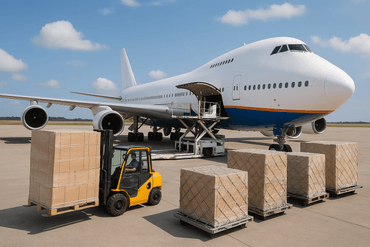
The ultimate guide to import custom duty



What is a customs duty?
Customs duty is an import tax levied by the customs authorities of a country on imported goods and merchandise.
It is often applied for various and sometimes overlapping reasons:
- To regulate foreign trade
- To tax foreign product to encourage or safeguard the domestic industry
- To increase revenue for the local government
- To penalize a certain country by applying higher duties on its products
- To retaliate against having higher duties applied on its products (this is also the gist of the current US-China trade war)
- etc.
Any imported merchandise from an international trade being transported via ocean freight, land, or air must be declared upon arrival. It must be accompanied by supporting documents including but not limited to the Bill of Lading, packing list, and commercial invoice.
Customs duty is an important factor to consider when estimating international shipping costs and should not be overlooked during business negotiations as they can add up to a rather significant amount. As an importer, you may also want to take this into consideration when pricing your goods for resale with a customs broker.
Customs duty definition
While customs duty is also commonly known as import duty, tax(es), or tariff(s), note that there is a slight difference between a duty and a tariff. A tariff is often the applicable rate in percentage, while duty is the amount of money that’s due.
For example, country A levies a 5% tariff on the import of pillows from country B. So for an import of $10,000 worth of pillows, customs duty of $500 will need to be paid.
Customs duty payment
Customs duty is paid immediately upon release to the importing country and the local customs authorities.
It is paid by the importer of record, who is also responsible for filing the proper and legal documentation required for the import. Unless stated otherwise, the importer of record can be a business or an individual and is usually the owner, buyer, seller of the merchandise, or an agent at destination.
Types of custom duties
There are many different kinds of customs duties applied across the globe. In this list, we will go through the most common customs duties you will encounter.
There may be other specific duties that are applicable to your shipment. To be sure of the duties you are required to pay, check with your freight forwarder or customs broker.
Basic customs duty
The basic customs duty, as its name suggests, is the basic duty imposed on imported goods. It can be levied on an ad valorem basis or as a specific rate (more on this later), which is determined by the local government.
Countervailing duty (CVD)
A countervailing duty is imposed on subsidized imports from other countries. Foreign governments sometimes provide subsidies and tax reliefs for their manufacturers to allow them to sell their merchandise at a lower price.
Under such circumstances, countervailing duties are levied by importing countries to prevent these imports from gaining an advantage in the local market by being sold at a lower price, which would put locally produced products at a disadvantage.
Countervailing duties are usually equivalent to the subsidies offered by the foreign government to level the playing field.
Anti-dumping duty
Just like the countervailing duty, anti-dumping duty is meant to protect the local industry. It is levied on goods deemed to have been imported at a very low price (below the market rate).
This may be done with the intention to sell them at a value that’s lower than the market rate to gain an unfair advantage or to get rid of excess stock. Anti-dumping duties on these goods to cover the difference and ensure fair competition.
Both anti-dumping and countervailing duties vary according to the country of origin of the imported goods and type of goods.
Safeguard duty
Safeguard duties are levied on products deemed to have been imported into a country in increasing quantities so large that it may be a threat to the local industry. It is imposed to protect the local economy and is often calculated based on the potential monetary losses incurred by local industries.
How to determine customs duty
To understand how to calculate customs duty, we must first understand how duty rates are determined. The two most common ways are known as ad valorem and specific.
- Ad valorem duties: Calculated as a percentage of the value of imported goods. Eg. 4.5% of the total value of imported pillows.
- Specific duties: Calculated based on weight or quantity of imported goods. Eg. $0.20 per gallon of imported gasoline.
Other ways to determine customs duty rates include:
- Mixed duties: The higher of a specific and ad valorem duty
- Compound duties: A combination of specific and ad valorem duties
- Rate quotas: Rates increasing on a scale. Eg. The less you import, the lower the rate, and vice versa
When obtaining a container shipping rate from your freight forwarder, always check to see if customs duty is included in the quote provided to you.
At iContainers, we do not include customs duty in our overall quote. But this can be calculated if you know the value of your declared goods, its commodity code, which gives you the applying duty rate, as well as any applicable rates or lack thereof from trade agreements.
Factors affecting customs duty
To calculate how much customs duty you need to pay for your merchandise, there are three main factors that you need to consider:
1. Applicable customs duty rates
Every importing country has its own customs duty rate for each type of merchandise, which is sorted and organized into different product codes. Depending on the country, the list of codes may be called HS Codes, HTS Codes, TARIC Codes, etc.
2. Customs or commercial value of goods
Most countries apply duty rates to either the customs or commercial value of goods. US customs duty rates, for example, are calculated based only on the goods’ commercial value. On the other hand, if you are importing into Spain, duties will be based on the goods’ customs value.
3. Origin of good
Depending on the country of origin of the merchandise, import restrictions and duties can vary greatly. It’s important to check whether there are special trade agreements between the countries of origin and destination that can affect duty rates.
What is the Harmonized System (HS)
The Harmonized System is a multipurpose and global nomenclature developed by the World Customs Organization to harmonize and classify products according to codes.
Also known as HS codes, they are accepted and used by all members of the World Trade Organization. The code attached to a particular good determines the customs duty rate applicable.
Make sure to check against the database of the importing country to confirm that you have assigned the correct code to your product. Any misassignment may cause delays to your shipment during customs clearance.
Different countries and regions may adapt the Harmonized System in their own way, but these adaptations are always based on the original six-digit HS code listed in the Harmonized System and are used to further categorize goods.
Some examples include the HTS (Harmonized Tariff Schedule) Code used in the US, TARIC code used by the EU, etc.
For a better understanding of the different codes, you may read our article on HS, HTC, and TARIC codes.
How to calculate the customs value of declared goods
There are six commonly used methods by customs authorities around the world to calculate the value of imported goods that are set by the World Trade Organization (WTO).
Of the six, the most popular method is called the transaction value method. Here’s how it works.
The customs value of goods is based on the amount of money paid by the buyer to the seller to acquire the merchandise. This includes any costs involved in bringing the merchandise to the point of import. That said, the value of a certain good can vary according to the Incoterm chosen and agreed upon by the importer and exporter.
In general, to calculate the customs value of a good, you need to sum up the following:
- Value of goods as listed on the commercial invoice
- Commissions
- Royalties or license fees
- Proceeds seller may receive from resales
- Processing or assembling costs
- Cost of goods preparation such as packing material, boxes, etc
- Cost of land transportation cost at origin
- Cost of maritime transport
- Cost of insurance
Note: Most importers make the mistake of declaring their intended sale prices to customers as goods value, and end up having to pay higher duties due to the higher value.
The transaction value method, while applicable to most imports, may not be suitable for some. To read more about the other methods, you may visit the WTO website on customs valuation. Alternatively, check with your customs broker.
Custom duty calculator
You can calculate customs duty yourself by looking up the commodity code of the merchandise you’re importing to obtain the applicable duty rate.
As mentioned earlier, most custom duty rates are determined by the customs value of the good. In the US, this is calculated differently (we will go into this later).
Multiply total customs value of your imported product by the duty rate and you’ll get an estimation of the customs duties you will be required to pay.
In other words:
[Customs duty rate] X [Total customs value of goods] = [Customs duties]
Note that these are just estimations. The customs authorities of the importing country has the final say on duty rates. When in doubt, speak to your customs broker.
What to keep in mind when calculating duties
Free Trade Agreements (FTA)
Check whether there’s a Free Trade Agreement in place between the origin country and destination country. Keep in mind that even though certain goods may be exempt from duties, they must still be declared to customs authorities.
De Minimis Threshold (DMT)
Different countries have different threshold levels under which duties are not applicable. Such thresholds, called De Minimis Threshold, or DMT, are usually more applicable to Small- and Medium-sized Enterprises (SMEs) instead of large companies who ship high-volume shipments.
However, these levels can vary greatly from country to country, so it is important to check for these thresholds if you are shipping low-valued merchandise. For example, the customs duty threshold for Canada is CAD$20 (approximately $15) and AUD$1000 (approximately $692) for Australia.
Payment
Verify duty payment methods and their due dates. While most duties must be paid upon entry, an extension can sometimes be granted.
It is important to ensure all duties are paid. Failure to do so may result in customs holding onto your shipment. You may also face monetary penalties and the possibility of having your goods seized. There is also a risk that you are entered into a compliance list which could result in more frequent customs inspections in the future.
Customs broker
If you find it too cumbersome and overwhelming to calculate and pay customs duty, you may want to consider reaching out to a customs broker for help. A customs broker will be responsible for declaring your import, paying your duties, and basically everything involved with the customs clearance process at destination.
US customs duty rates
If you’re shipping to the US, pay extra attention to this section.
US customs duty rates are determined by the US Congress. While most countries determine customs duty rates based on the price of the goods, insurance cost, and freight cost, in the US, this is based only on the value of the goods.
Despite popular belief, the DMT for goods entering the US is $800 and not $2,500 as listed on some websites. That is to say that shipments valued over $800 are subject to customs duty.
Shipments valued at over $2,500 are required to file for a customs bond for customs clearance purposes. A customs bond acts as a guarantee that the applicable duties will be paid.
US customs duty must be paid in US dollars and can be paid with a check. Certain ports of entry also accept credit cards.
HTS codes
The US uses a variation of the Harmonized System called the Harmonized Tariff Schedule, or HTS. It’s published annually by the US International Trade Commission (USITC) and enforced by the US Customs and Border Protection (CBP).
The HTS is based on the HS code, but broken down into more specific product categories. I.e. An HS code consists of six digits, whereas an HTS code is between eight and ten digits, of which the first six are a HS code.
You may search for your product’s HTS code on the USITC website.
US trade agreements
US customs duty rates may be reduced when importing from countries with which the US has international trade agreements. These include neighboring Canada and Mexico, which are part of the North American Free Trade Agreement, or NAFTA.
Here’s a list of countries that have FTAs with the US. Note that not all products imported from a country that has a trade agreement with the US are eligible for reduced duty rates.
To check whether the product you’re importing is eligible for reduced duty, consult the official HTS list published by USITC or check with your customs broker. Note that the duty rates on the list only provide an estimation and that CBP has the final say on the correct rate.
Calculating US customs duties: An example
To illustrate how to calculate US customs duties, let’s take the case of an FCL shipment of tools from China.
This is the information you have at hand.
- Importing country: US
- Exporting country: China
- HTS Code: 9903.88.01
- Goods: Tools
- Value of commercial cargo: $12,000
Keeping in mind that the US customs duties are calculated based only on the value of the goods, with the above information, you have everything you need to determine the duties due for this shipment.
Calculating how much customs duties is payable can be easily done in three easy steps.
- Step 1: Determine your duty rate by entering the product’s HTS Code into the USITC’s HTS search website.
- Step 2: Check whether there are trade agreements with China and for this particular good. In this case, the duty rate is set at 25%.
- Step 3: Multiply the duty rate (25%) by the commercial value of the cargo ($12,000).
Duties payable: 25% x $12,000 = $3,000
Calculating other import duty rates
If you are importing to other countries, other factors may need to be taken into consideration when calculating import duties.
For example, calculating import duties for the exact same import into Spain will have to be done differently. For starters, it will be based on the customs value (value of goods, freight cost, and insurance) instead of the value of the goods.
Here’s the shipment information you have.
- Importing country: Spain
- Exporting country: China
- HTS Code: 9903.88.01
- Goods: Tools
- Value of commercial cargo: €10,665
- Ocean freight rate: €1,310
- Insurance: 0.3% of cargo value (assuming no insurance was taken out and ‘customs insurance’ applies)
To calculate customs value, add goods value, ocean freight rate, and insurance.
€10,665 + €1,310 + 0.3% x €10,665 = €12,007
The final step would be to multiple the duty rate applicable to the imported product to the above-calculated customs value to get determine the amount of import customs duties payable.
- 1. What is a customs duty?Customs duty definitionCustoms duty payment
- 2. Types of custom dutiesBasic customs dutyCountervailing duty (CVD)Anti-dumping dutySafeguard duty
- 3. How to determine customs dutyFactors affecting customs dutyWhat is the Harmonized System (HS)
- 4. How to calculate the customs value of declared goods
- 5. Custom duty calculator
- 6. What to keep in mind when calculating dutiesFree Trade Agreements (FTA)De Minimis Threshold (DMT)PaymentCustoms broker
- 7. US customs duty ratesHTS codesUS trade agreementsCalculating US customs duties: An example
- 8. Calculating other import duty rates
Related Articles


